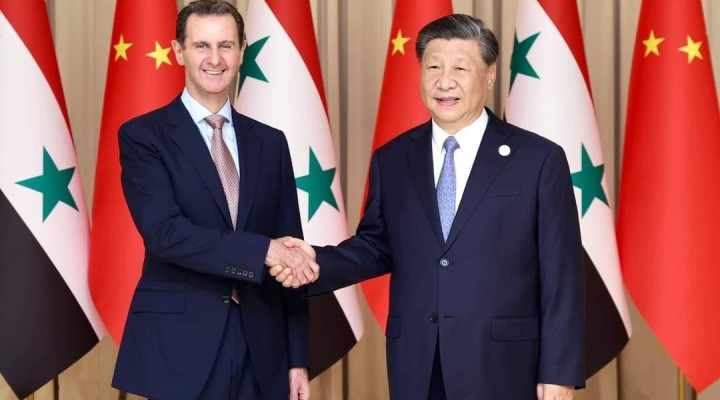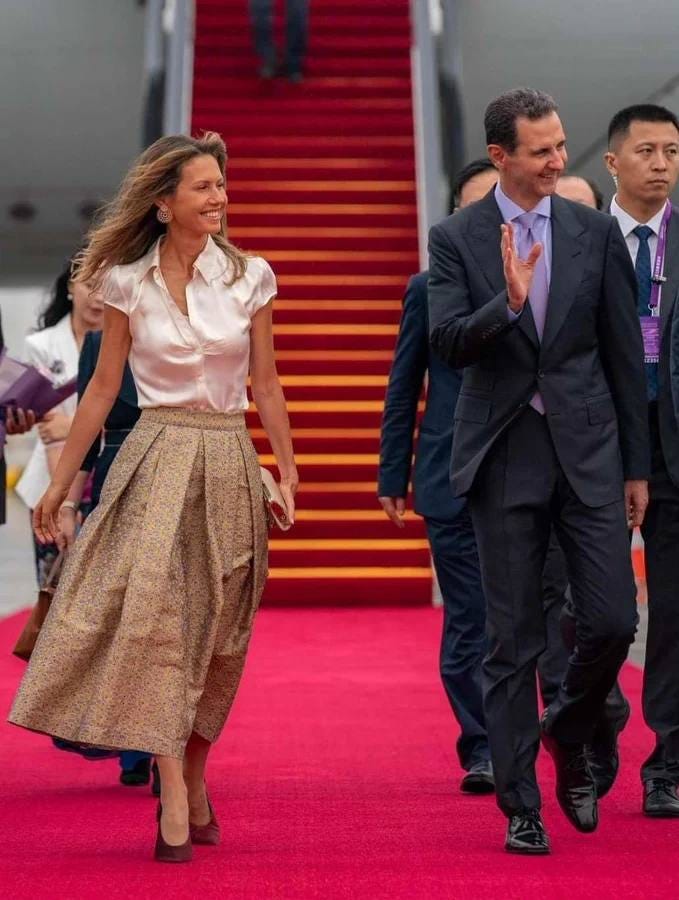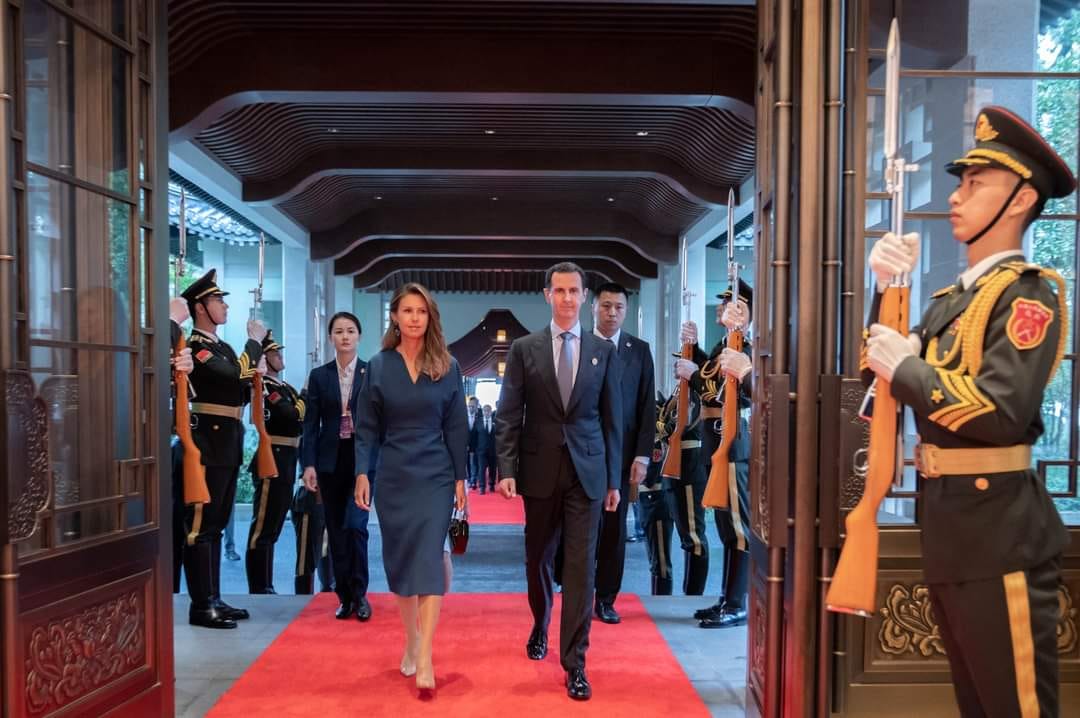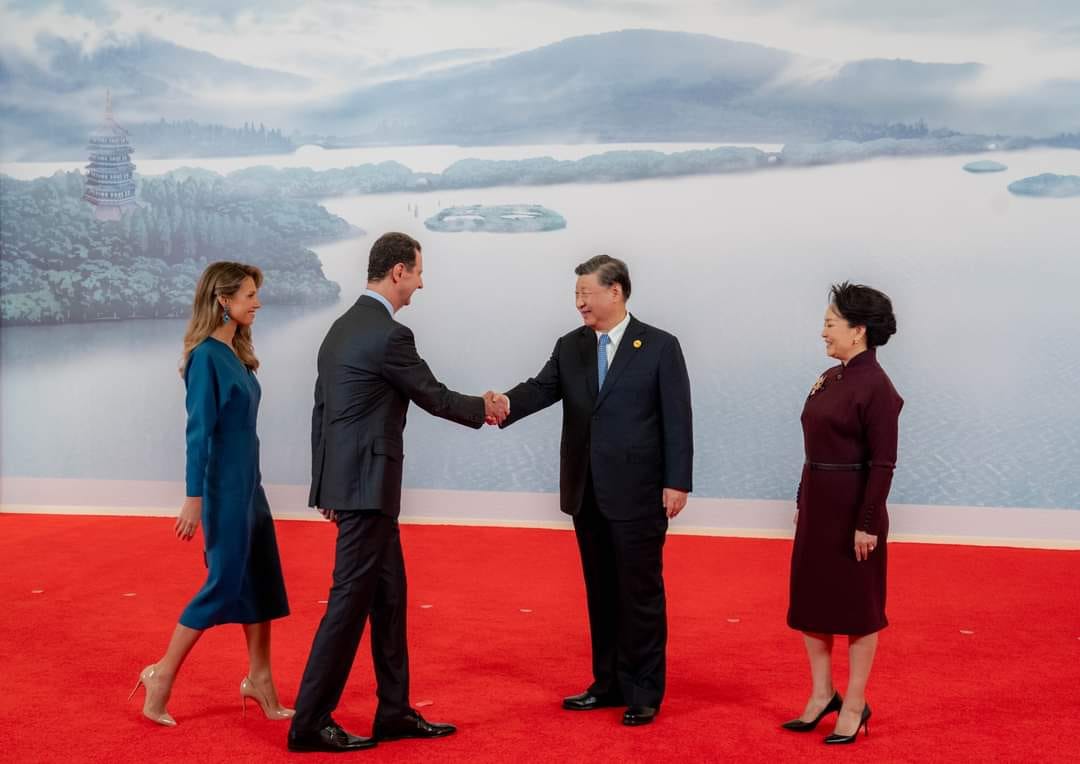Assad and Xi summit heralds a new dawn in East and West Asia relations

President Assad’s first visit to China since 2004 is a historic event
The two Presidents sign multiple memorandums of understanding in Guangzhou and Beijing.
On Thursday 21st September President Assad and the First Lady, Asma Al Assad arrived at the Chinese city of Ghuangzhou as honoured guests of President Xi Jinping. The Chinese President had chartered a private plane to bring Assad and his wife to China for their first visit since 2004.
The Assad Xi summit began on a foggy, damp day in Ghuangzou but the warmth of the welcome was palpable. Many have spoken about the symbolism of the First Lady’s outfit which was of the finest silk damask to honour the historical importance of the Silk Road now transformed into the Belt and Road Initiative that Syria joined officially in January 2022. It is rare these days that we see such a nod to history, culture and civilisation from Western leaders.

The Syrian delegation accompanying the President was a high level one – including Dr. Faisal Mikdad, Foreign Affairs Minister and long term advisor to the Presidency, Dr. Bouthaina Shaaban. The plan was to hold a summit meeting and a discussion session and a luncheon in honour of President Assad and Asma. Assad and the delegation would then travel to Beijing to meet with senior Chinese officials and to discuss future economic cooperation projects and to sign a number of bilateral agreements.
The two Presidents seal the future of the Belt and Road Initiative
Xi Jinping referred to the sixty seven years of Syrian-Chinese relations that have remained steadfast despite the ever changing international landscape. Syria is perceived as a strategic partner in the Belt and Road Initiative. Xi also supports Syria joining the Shanghai Organisation as a partner for dialogue.
China supports Syria’s battle against hostile external interference, rejects the occupation of Syrian territory by illegal forces and urges the lifting of economic sanctions which unilaterally punish the Syrian people for resisting regime change since 2011.
President Xi also acknowledged Syrian support over US interference in Taiwan.
President Assad described China as an advanced and economically strong nation but one that has not lost its humanity unlike developed counterparts in the West.
Rather, according to Assad, China plays a major role in bringing balance to the global political sphere and in developing a win-win cooperation paradigm. Syria will remain a loyal friend of China because they are united in principles and vision for the region.
Assad reiterated support for ‘One China’ and supports initiatives proposed by Xi that envision a secure future for Humanity.
Assad confirmed the need to confront Western military power with the principles of soft power based on ethical trade and cooperation that China has adopted.
Assad considered this to be a historic visit, one that comes as a multipolar world is being created that will restore global equilibrium and stability.
Perhaps most importantly for the Syrian people, there were extensive discussions about the restoration and development of the electricity, oil and gas sectors in Syria that have been decimated by the 12 year proxy war and with the US still occupying the north-east oil-rich region of Syria.

President Al Assad and First Lady Asma Al Assad arrive for the welcome banquet in Ghangzhou and the opening ceremony of the 19th Asian Games.
“China is a rising power, it is important. Most of the world has different kinds of relations with China whether in science, politics, economy, business – in every field you need China now. And our relationship for the future is going to be on the rise. It was good, but it will be better because when a country like China proves that it is a real friend, a friend you can rely on, it is very natural to have a better relationship on the popular level, not only on the formal level”
President Assad – March 2017
President Xi described China’s role in the region at a meeting of the Arab League in 2016:
Instead of looking for a proxy in the Middle East, we promote peace. Instead of seeking any sphere of influence, we call on all parties to join the circle of friends for the Belt and Road initiative. Instead of attempting to fill the “vacuum” we are building a cooperative partnership network for win-win outcomes.
The Chinese Arab Policy paper published in 2016 is well worth reading. “Over two thousand years ago, land and maritime Silk Roads already linked the Chinese and Arab nations. The policy paper emphasises historic cooperation, peaceful relations and the openness of diverse civilizations to each other’s perspectives. It seeks to build relations based on trust, regional peace, stability and mutually beneficial economic development.
In July 2018 President Xi gave a speech at the opening ceremony of the Eighth Ministerial Meeting of the China-Arab States Cooperation Forum. Xi proposed a road map that incorporated economic partnership and multi-dimensional cooperation in politics, culture and technology.
The future of trade ties between China and the Arab nations, including Syria. would be channelled through the BRI and the 1+2+3 system. The core of this pattern is hydrocarbon-based energy, its two branches are infrastructure construction and trade and investment facilitation. There is a third sector of development that includes new energy, nuclear energy and space exploration.
The BRI with its focus on developing infrastructure, open trade and connectivity between continents will be a major component of any Syrian strategy for reconstruction.
In August 2017 President Assad coined the phrase “Heading East” when he informed the Syrian foreign service to embark on a revision of Syria’s international relations – the pivot East.
Syria and the Ancient Silk Road
Relations between East and West Asia span three millennia. The Ancient Silk Road was originally concentrated in two or three overland routes and one sea route. The most important began in the city of Chang’an, capital of Tang China, running through Central Asia to Persia and then into ancient Syria and the Arabian Peninsula reaching the cities of Palmyra and Petra in Syria and Jordan respectively.
From Petra, the trade caravans would head to Alexandria in Egypt and then towards Rome. At a later stage Palmyra rather usurped Petra and dominated the trade scene. Palmyra is located at the centre of the Levant, the midpoint between Mesopotamia and the Mediterranean.
Crossing the Syrian desert was one of the shortest and most accessible of the Ancient Silk Road routes.
Palmyra developed into a quasi empire built on the riches acquired through the Silk Road trade until Roman imperial armies besieged, destroyed and looted the great Syrian city state in 273 AD bringing the Palmyrene Empire to an early demise.
Of course during the regime change war waged against Syria, the Western-backed ISIS terrorists looted, destroyed and besieged Palmyra again until liberation in 2016 and re-liberation in 2017 by the Syrian Arab Army and allies.
In the North-East of Syria is the ancient city of Dura-Europos located between the modern day cities of Al Mayadin and Al Bukamal (border crossing with Iraq coveted by the US) in the Syrian governorate of Deir Ezzor, another region that has been targeted both by ISIS, the US military and their proxy Kurdish Separatist militia.
Dura Europos became one of the main hubs of the Ancient Silk Road.
Today, as I stand here and look back at history, I seem to hear the camel bells echoing in the mountains and see wisps of smoke rising from the desert and this gives me a specially good feeling
President Xi Jinping – September 2013
The much fought-over city of Aleppo is located at the crossroads of trade routes between East and West, straddling a strategic position connecting Anatolia, the Mediterranean and Europe.
The city of Antioch, now annexed by Turkiye, is located West of Aleppo on the Orontes River and was also an important trade hub for the Silk Road caravans which journeyed from Antioch eastwards – through Aleppo, modern day Jarablus (occupied by Turkish proxy armed groups) towards Persia and East Asia to trade commodities with Chinese traders. Antioch was also a hub for traders from the Arabian Peninsula and Yemen via Palmyra.
It is not coincidental that these cities and regions were targeted early on in the regime change war by the West and Turkiye (NATO member state) in a clear attempt to take control of the primary hubs along the Ancient Silk Road that would also play a pivotal role in the new Chinese Belt and Road Initiative.
The Five Seas Project
Ever since President Bashar al-Assad first announced the Five Seas vision in 2004 as a response to the newly virulent regime change operation launched in the wake of 9/11, the battle lines have been clearly drawn over two opposing destinies shaping the Arab world. When the western-directed Arab Spring of color revolutions sabotaged the efforts of the Five Seas program (and also broader Libyan plans for a Great Manmade water project funded by a gold backed Dinar), things took a very dark turn.
Ehret outlines the the Five Seas strategy as “the construction of rail, roads, and energy grids connecting the water systems of the Mediterranean, Persian Gulf, Black Sea, Red Sea, and Caspian Sea with Syria. The project serves as a logical node uniting the diverse nations of Mackinder’s world island behind a program of harmonization, integration and win-win industrial cooperation.”
In a 2009 interview, President Assad described this project passionately:
“Once the economic space between Syria, Turkey, Iraq and Iran becomes integrated, we would link the Mediterranean, Caspian, Black Sea, and the [Persian] Gulf . . . we aren’t just important in the Middle East . . . Once we link these four seas, we become the unavoidable intersection of the whole world in investment, transport, and more.”
These weren’t empty words. By 2011, Assad had led delegations and signed agreements with Turkey, Romania, Ukraine, Azerbaijan, Iran, Iraq, and Lebanon to begin the Five Seas projects.
This was done at a time when Libya’s President Qaddafi was well underway in building the Great Man-Made River, the largest water project in history alongside a coalition of nations that included Sudan, Ethiopia, and Egypt.
The stark difference between US and Chinese policy for Syria
According to an NGO established by Dr. Bouthaina Shaaban to record the human rights abuses committed by the Western-backed terrorist groups – Wathiqat Wattan Foundation:
The foreign policy of China is built on the Five Principles of Peaceful Coexistence – its main axioms are respect for all nation’s territorial integrity, sovereignty, non-interference in internal affairs and cooperation based on mutual benefits.
China, a permanent member of the United Nations Security Council (UNSC) has repeatedly referenced these principles when voting against Western-proposed resolutions entailing grave interventions in Syrian internal affairs.
On the 4th October 2011, Russia and China vetoed a UNSC draft resolution on Syria put forward by the US alliance. This was the first of seven vetoes by China (half of the vetoes ever cast by China at the UNSC) that not only placed essential obstacles in the path of the US/UK-led agenda but also upheld the principles of the United Nations Charter that has been corrupted by the US and other aligned member states.
According to a paper published by Wathiqat Wattan Foundation:
The BRI is a Chinese program that aims to maintain an ‘open world economic system and achieve diversified, independent, balanced and sustainable development’. It is also a Chinese proposal intended to ‘advance regional cooperation, strengthen communication between civilisations and safeguard world peace and stability’. The general thrust is towards an equitable, more inclusive, multilateral global order. It is open to all nations and does not require conformity to a fixed political or economic model. On the contrary, the initiative thrives on the diversity of nations taking part.

President Assad, First Lady Asma Al Assad meet with President Xi Jinping and First Lady Peng Li Yuan at the welcome banquet for the 19th Asian Games in Ghangzhou.
China can contribute to every sector with no exception, because we have damage in every sector. When we talk about the current situation before the comprehensive reconstruction process starts, China is now involved directly in implementing many projects, mainly industrial ones in Syria and we have many Chinese experts here working to set up different sectors. When there is more stability, the most important goal is to rebuild the destroyed areas. The second is the infrastructure, the sanitation systems, electricity and oil fields. The third is the industrial sector and projects, whether private or public sector.
President Assad in 2017
It is worth noting that before the war was kicked off by the West in 2011, China was a primary trade partner of Syria and Syria an important market for Chinese products. In 2010 trade between the two countries was $ 2.2 billion. 99% of the trade value was in Chinese imported goods to Syria.
China has maintained a policy of assistance throughout the twelve year crisis and regular Syrian Chinese discussions on trade cooperation, investment, education, health, energy, telecommunications, transport have continued unabated.
The Assad Xi summit is a landmark one which has demonstrated to the West that they are no longer driving the agenda in the region through piracy and disproportionate military force.
There is a new dawn rising and Syria is a hub that all nations have effectively been fighting over and for – the difference is that China appears to foster dialogue, peace and development while the West is hellbent on destruction and subjugation.
Chinese Foreign Ministry Spokesman, Geng Shuang in 2017:
“Too many people in the Middle East are suffering at the brutal hands of terrorists. We support regional countries in forming synergy, consolidating the momentum of anti-terrorism and striving to restore regional stability and order. We support countries in the region in exploring a development path suited to their national conditions and are ready to share governance experience and jointly build the Belt and Road and promote peace and stability through common development.”
Below is my short segment for UK Column on the current situation in the southern districts of Syria and Assad’s visit to China.
https://beeley.substack.com/p/assad-and-xi-summit-heralds-a-new
 TheAltWorld
TheAltWorld 
0 thoughts on “Assad and Xi summit heralds a new dawn in East and West Asia relations”